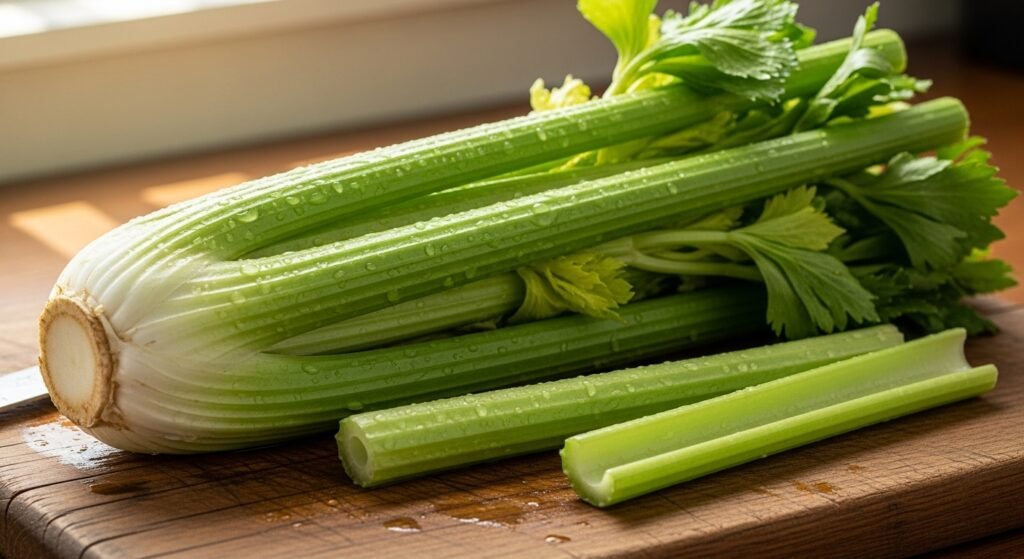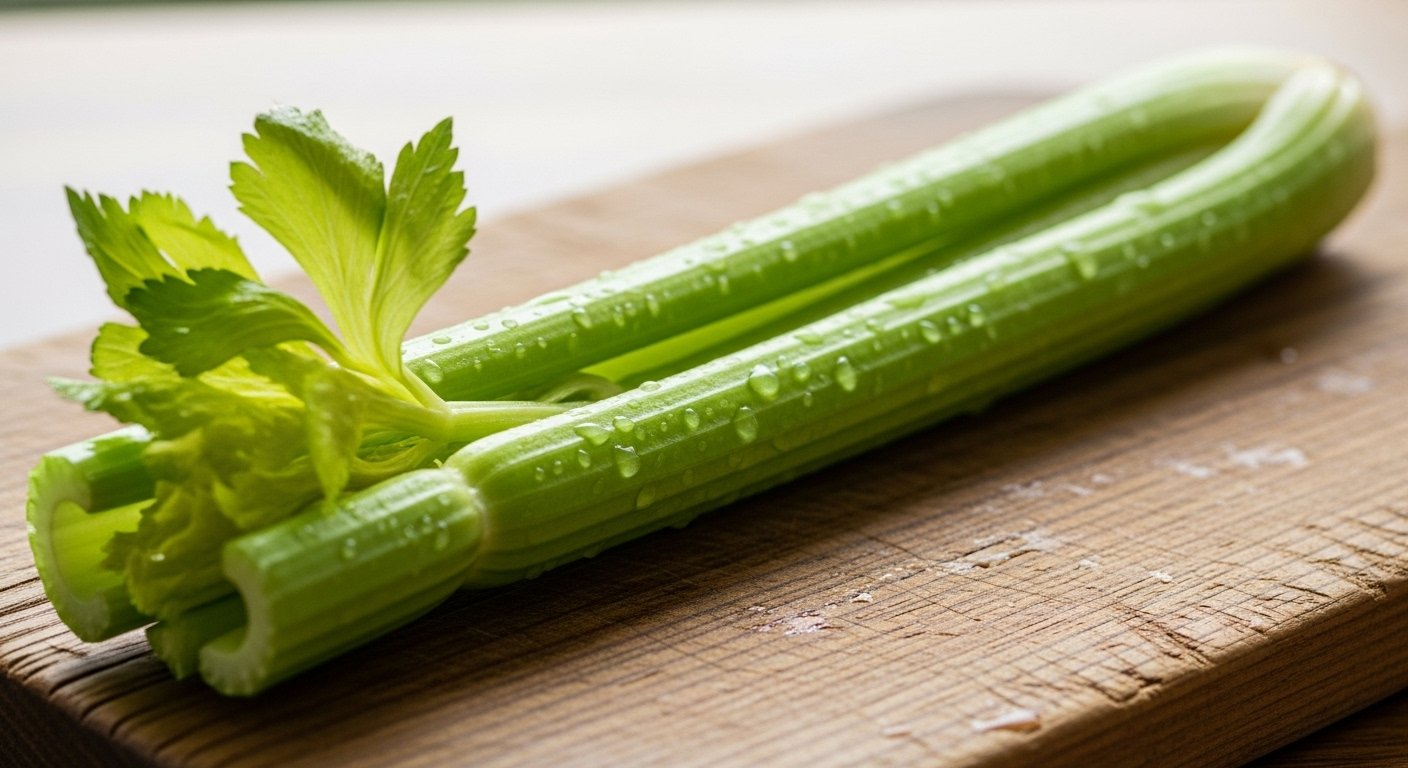Table of Contents
When you hear someone talk about “superfoods,” your mind might jump to kale, blueberries, or chia seeds. But there’s one bold, crunchy veggie that has quietly earned a place on that list too—pravi celer, also known as real celery. You’ve likely seen it in a salad, a soup, or on a veggie tray, but this mild, green stalk offers a lot more than you might think. Pravi celer isn’t just water and crunch. It’s full of vitamins, minerals, and plant compounds that support your health in so many surprising ways. From helping digestion and reducing inflammation to improving hydration and offering a low-calorie snack option, celery has earned its reputation the natural way. This long, crunchy plant has been part of meals and folk remedies for centuries, and it’s now being rediscovered by health lovers and cooks alike. In this easy-to-follow guide, we’ll explore what pravi celer is, where it comes from, how to eat it, and why it should become a regular guest in your kitchen. Whether you’re a picky eater, a curious cook, or someone trying to live a little healthier, this article is filled with everything you need to know about proč pravi celer deserves a spot on your plate every day.
What Is Pravi Celer?
Pravi celer means “real celery” in many Slavic languages. It refers to the common celery plant, scientifically known as Apium graveolens. This crunchy green vegetable grows in stalks and is popular around the world. It has a light, refreshing taste and is often enjoyed raw or cooked in soups and stews. While many people think of celery as a simple snack, pravi celer has deep roots in both cooking and healing traditions. It’s versatile, low in calories, and packed with vitamins like A, K, and C, along with minerals such as calcium and potassium. That’s why it’s loved by both foodies and health experts.
A Short History of Pravi Celer
Celery has been around for thousands of years. The use of pravi celer dates back to ancient Egypt, Greece, and Rome. In those times, it wasn’t always used for food. It was also valued for its healing properties. The plant was seen as a symbol of life and strength. In medieval Europe, celery became a common garden herb used in cooking and medicine. By the 1600s, people started growing it more widely for eating. Over time, farmers cultivated milder, sweeter versions of the plant, and today, pravi celer can be found in grocery stores all over the world. It’s one of the few “ancient” veggies still truly loved in modern kitchens.
Nutritional Benefits of Pravi Celer
You may look at a stalk of celery and think, “Just water.” But the truth is, pravi celer offers way more. It’s low in calories—just 10 calories per stalk—but high in important nutrients. It gives you vitamin K for strong bones, vitamin C to support your immune system, and potassium which helps keep your heart healthy. Celery also contains special plant compounds called antioxidants, which help your body fight inflammation and damage from stress. It’s 95% water, so it keeps you hydrated too. If you’re looking for a snack that fills you up without filling you out, pravi celer is a smart pick.
Why Pravi Celer Is Great for Digestion
One big reason people fall in love with pravi celer is how it helps your stomach. Celery contains both water and fiber—two things your digestive system loves. The fiber keeps things moving comfortably, while the water helps soften food and ease digestion. Pravi celer is also known to reduce bloating, thanks to its natural compounds that help clear out excess water and salt. Some people even eat celery juice in the morning to help start the day with a gentle gut cleanse. Whether raw or cooked, celery supports your belly in ways that feel light but effective.
How Pravi Celer Helps Reduce Inflammation

Our bodies deal with stress all the time—whether from food, pollution, or illness. One way to protect your body is by eating anti-inflammatory foods, like pravi celer. This vegetable contains dozens of plant compounds, including apigenin and luteolin, that have been found to reduce swelling in the body. These compounds support your cells and help calm down inflammation that can lead to illness or pain. People with arthritis, skin problems, or gut inflammation may benefit from adding more pravi celer to their meals. It’s an easy and natural way to help your body feel better from the inside out.
Pravi Celer in Traditional Medicine
Long before science could name all its nutrients, pravi celer was trusted in folk medicine. In many cultures, celery seeds and stalks were used to treat everything from high blood pressure to digestion problems. It was also thought to help with anxiety and sleep. Herbal healers often used celery seeds to make calming teas or healing oils. Even modern studies support some of these ancient uses—especially for heart health and blood sugar control. While celery isn’t a magic cure, it’s a gentle and natural food that has earned respect for helping the body stay balanced and well.
How to Eat Pravi Celer – Fresh, Cooked, or Juiced
There are many delicious ways to enjoy pravi celer. You can eat it raw by slicing it into sticks for a crunchy snack or dipping it into hummus or peanut butter. You can slice it for salads, use it as a base in soups, or cook it with meats and grains for added flavor. Pravi celer softens when cooked, and its mild taste mixes well with other ingredients. You can also juice it. Celery juice is trending for its health benefits and fresh taste. Just blend stalks with a bit of water and strain for a simple drink. However you eat it, celery adds nutrition, freshness, and fiber to your plate.
Is Celery Juice Really That Good?
You’ve likely seen people rave about celery juice online. Some call it a miracle drink. But what’s the truth? Drinking pravi celer juice can be healthy when done right. It’s full of vitamins, minerals, and water. It may help with digestion, reduce bloating, and support clear skin. But it’s not a cure-all. Drinking celery juice should be part of a balanced diet—not the only thing you do for health. Also, juicing removes much of the fiber that helps your digestion. So, it’s best to enjoy both juice and whole celery depending on your needs. Listen to your own body to decide what feels good.
How to Grow Your Own Pravi Celer
Gardening celery takes time and care, but growing your own pravi celer can be very rewarding. Celery prefers cool weather and moist soil. You can grow it from seed or from the base of a store-bought stalk. Just place the trimmed root end in water, and after a few days, you’ll see tiny green shoots. Move it to a pot with rich soil and keep it well-watered. In a few months, your celery will be ready to harvest. Growing it at home gives you fresh, chemical-free stalks you can enjoy any time. Plus, it’s fun for kids and families to try together.
Easy Recipes That Use Pravi Celer
Need a reason to cook with celery? Here are a few tasty and simple ideas using pravi celer. Try chopping it into chicken or veggie soup for better flavor and texture. Slice it into stir-fries for a light crunch. Make a celery-apple salad with yogurt and walnuts for a sweet, healthy side. Add diced celery to egg salad or tuna salad for a fresh upgrade. Roasting celery with olive oil and garlic makes a soft, caramelized side dish. The options are endless. Celery’s mild taste allows it to blend in or stand out, depending on how creative you want to be.
Common Myths About Pravi Celer
There are a few myths about pravi celer that need clearing up. One common idea is that celery has “negative calories.” That means some people think it takes more calories to digest than it gives. That’s not entirely true. While celery is low in calories, your body still gets energy from it. Another myth is that it’s not very nutritious. That’s also false. As you’ve read, celery carries vitamins, minerals, and plant elements that support your whole body. It may not look super fancy, but celery is a quiet powerhouse in the world of veggies.
Who Should Be Careful With Pravi Celer?
While pravi celer is healthy for most people, there are a few things to note. Celery contains natural salts and compounds that, in large amounts, can affect people sensitive to sodium. Some people may also have food allergies or sensitivities to celery. If you’re on a medication that affects your kidneys or water balance, ask your doctor if celery is safe for your needs. And like any food, it’s best to eat it in balance with other vegetables, proteins, and carbs. Celery is a helper, not a cure. Eat it wisely and enjoy its benefits fully.
FAQs About Pravi Celer
Q1: What is pravi celer?
A: Pravi celer means “real celery.” It’s a healthy, crunchy veggie used in cooking and natural health.
Q2: Is celery good to eat every day?
A: Yes! Eating celery daily can support digestion, reduce inflammation, and help with hydration.
Q3: Can I juice pravi celer at home?
A: Absolutely. Blend celery with water and strain for a fresh, clean, and healthy drink.
Q4: Does celery really help with weight loss?
A: Celery is low in calories and keeps you full. It supports weight loss when combined with a good diet.
Q5: Can children eat pravi celer?
A: Yes, it’s safe for kids. Just cut it into small pieces to make chewing easier and safer.
Q6: Can I grow celery myself?
A: Yes! Pravi celer grows well in pots or gardens with moist, cool conditions and a little patience.
Conclusion
Pravi celer might look simple, but it’s one of nature’s unsung heroes. It brings hydration, vitamins, fiber, and flavor all at once. It’s easy to eat, simple to cook, and packed with benefits. Whether you snack on raw sticks, cook it into comfort food, or drink it as a morning juice, celery plays a smart role in any healthy lifestyle. And thanks to its long history and trusted benefits, you can enjoy it without worry. So next time you shop, grab some fresh pravi celer and see just how many tasty and helpful ways you can use it. Healthy choices don’t have to be complicated—they can be as crisp and green as a single stalk of celery.



